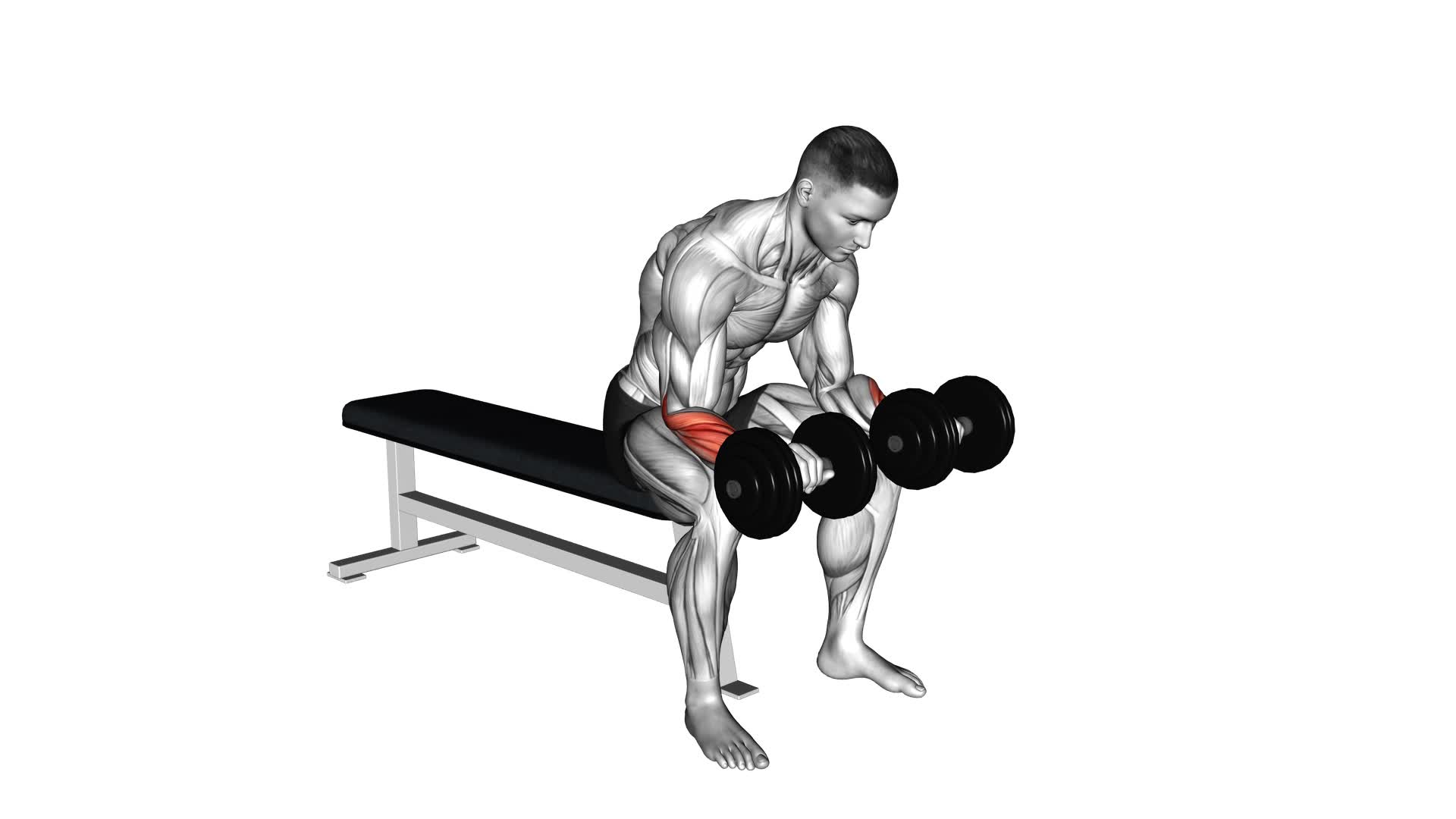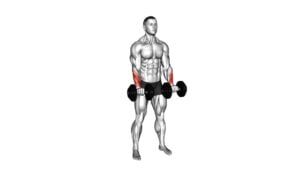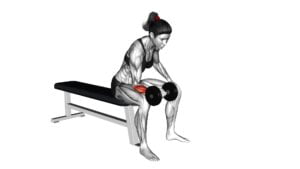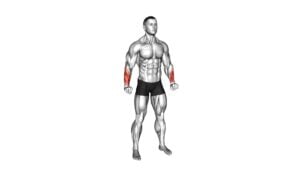Dumbbell Reverse Wrist Curl – Video Exercise Guide & Tips

Looking to strengthen your wrists and forearms? The dumbbell reverse wrist curl is a fantastic exercise for targeting those areas. In this video exercise guide, you'll learn the proper form and technique to maximize your results.
Watch This Exercise Video
Discover variations and progressions to challenge yourself and avoid common mistakes. Plus, we'll provide tips on how to incorporate this exercise into your routine and safety precautions for beginners.
Get ready to take your wrist and forearm strength to the next level!
Key Takeaways
- Targets muscles in wrists and forearms
- Increases wrist strength
- Promotes forearm development
- Enhances grip strength and wrist stability
Benefits of the Dumbbell Reverse Wrist Curl
You'll experience stronger forearm muscles when you incorporate the dumbbell reverse wrist curl into your workout routine. This exercise specifically targets the muscles in your wrists and forearms, helping to increase wrist strength and promote forearm development. By holding a dumbbell with an overhand grip and curling your wrists upwards, you engage the muscles on the back of your forearms, such as the extensor carpi ulnaris and extensor carpi radialis longus. These muscles play a crucial role in wrist extension and stabilizing the wrist joint. As you perform the reverse wrist curl, you'll feel a burn in your forearms, indicating that the exercise is effectively working those muscles.
Strengthening your wrists and forearms not only enhances your overall grip strength but also improves your performance in various sports and activities that require wrist stability, such as tennis, golf, and weightlifting. Additionally, developing strong forearms can help prevent injuries, as they provide support and stability to the wrists during movements and exercises.
Now that you understand the benefits of the dumbbell reverse wrist curl, let's move on to the next section, where we'll discuss the proper form and technique for this exercise.
Proper Form and Technique for the Exercise
To perform the dumbbell reverse wrist curl with proper form and technique, how should you position your body and grip the dumbbell?
- Start by sitting on a bench or chair with your feet flat on the ground. Place your forearms on your thighs, palms facing down.
- Grasp a dumbbell in each hand using an overhand grip, with your palms facing towards the floor.
- Begin the exercise by slowly curling your wrists upward, lifting the dumbbells towards your body as high as possible. Keep your forearms stationary throughout the movement.
- Pause briefly at the top of the movement, then slowly lower the dumbbells back down to the starting position, allowing your wrists to extend fully.
- Repeat the exercise for the desired number of repetitions.
Proper form and technique are crucial when performing wrist strength exercises like the dumbbell reverse wrist curl. By positioning your body correctly and using the appropriate exercise equipment for wrist curls, you can target the muscles in your forearms effectively.
Remember to start with lighter weights and gradually increase the load as your strength improves. It's also essential to maintain control throughout the exercise, avoiding any jerking or swinging movements.
Variations and Progressions to Challenge Yourself
As you progress in your wrist strength training, there are several variations and progressions that you can incorporate to challenge yourself further. These variations won't only enhance the effectiveness of the dumbbell reverse wrist curl exercise, but also target different muscles in your forearms.
One variation you can try is the single-arm dumbbell reverse wrist curl. Instead of using both arms simultaneously, you'll focus on one arm at a time. This variation allows for greater isolation and can help correct any muscular imbalances between your arms.
Another advanced technique is to perform the exercise on an incline bench. By lying face down on an incline bench with your arms hanging over the edge, you'll increase the range of motion and intensify the workout for your forearms.
Additionally, you can experiment with different grips during the exercise. Using a neutral grip, where your palms face each other, will target the brachioradialis muscle more intensely. Alternatively, a pronated grip, with palms facing down, will emphasize the extensor muscles of the forearm.
Common Mistakes to Avoid During the Exercise
To ensure proper form and maximize the benefits of the dumbbell reverse wrist curl, it's important to be aware of common mistakes to avoid during the exercise. Here are three common mistakes to watch out for when performing the wrist curl technique:
- Using too much weight: One common mistake is using weights that are too heavy. This can lead to improper form and increase the risk of injury. Start with a lighter weight and gradually increase as you become more comfortable and confident with the exercise.
- Poor wrist positioning: Another mistake is incorrect wrist positioning. Make sure your wrists are in a neutral position throughout the exercise, with your palms facing down. Avoid bending your wrists or allowing them to drop during the movement.
- Using momentum instead of control: It's important to focus on controlled movements rather than using momentum to lift the weights. Avoid swinging or jerking your wrists to lift the dumbbells. Instead, engage your forearm muscles and use a slow and controlled motion to lift and lower the weights.
Tips for Incorporating the Dumbbell Reverse Wrist Curl Into Your Routine
To effectively incorporate the dumbbell reverse wrist curl into your routine, it's important to focus on proper form techniques. Keep your wrists straight and maintain a controlled movement throughout the exercise.
Additionally, understanding the benefits of wrist curls, such as improved grip strength and forearm development, can help motivate you to include this exercise in your workout regimen.
Proper Form Techniques
Incorporate the dumbbell reverse wrist curl into your routine by focusing on proper form techniques. Here are three essential tips to maximize the effectiveness of this exercise:
- Positioning:
- Sit on a bench or chair with your feet flat on the floor.
- Hold a dumbbell in each hand, palms facing down.
- Rest your forearms on your thighs, allowing your wrists to hang off the edge.
- Range of Motion:
- Start by curling your wrists upward, lifting the dumbbells towards your body.
- Pause for a moment at the top, then slowly lower the dumbbells back to the starting position, allowing your wrists to extend fully.
- Control and Stability:
- Maintain a stable and controlled movement throughout the exercise.
- Avoid using momentum or swinging your arms.
- Focus on engaging your forearm muscles to perform the wrist curl with precision.
By following these proper form techniques, you can ensure that you get the most out of your dumbbell reverse wrist curls.
Now, let's explore the benefits of incorporating this exercise into your routine.
Benefits of Wrist Curls
Maximize your workout results by incorporating the dumbbell reverse wrist curl into your routine and experience the benefits of strengthening your wrist and forearm muscles. Building wrist strength is crucial for overall upper body strength and stability. Strong wrists can improve your performance in various activities, such as weightlifting, yoga, and sports that require gripping or throwing.
Additionally, wrist exercises are essential for injury prevention. Strengthening your wrists can help reduce the risk of common injuries like wrist sprains and strains. The dumbbell reverse wrist curl specifically targets the muscles in your forearms and wrists, helping to improve grip strength and flexibility. By adding this exercise to your routine, you can enhance your overall fitness and protect yourself from potential injuries.
Now, let's move on to the next section to learn about safety precautions and modifications for beginners.
Safety Precautions and Modifications for Beginners
When performing the dumbbell reverse wrist curl, it's important to prioritize proper form to avoid injury.
Start with lighter weights and gradually increase the weight as you become more comfortable and confident in your technique.
This gradual progression will help prevent strain or strain on the wrists and ensure a safe and effective workout.
Proper Form Importance
To ensure safety and make modifications easier for beginners, focus on maintaining proper form during the dumbbell reverse wrist curl exercise. Here are three important aspects to consider:
- Wrist Alignment: Keep your wrists in a neutral position throughout the exercise. Avoid excessive bending or twisting, as this can strain the joints and increase the risk of injury. Proper alignment helps in developing wrist strength and preventing wrist injuries.
- Controlled Movement: Perform the exercise with controlled and deliberate motions. Avoid swinging or jerking the weights, as this can put unnecessary stress on the wrists and compromise form. Slow, controlled movements allow for better muscle engagement and reduce the risk of accidents.
- Grip Strength: Pay attention to your grip on the dumbbells. Ensure a firm and secure grip, but avoid squeezing too tightly, as this can strain the wrist joints. A balanced grip allows for better control and reduces the likelihood of dropping the weights.
By focusing on these aspects of proper form, you can maximize the benefits of the dumbbell reverse wrist curl exercise while minimizing the risk of wrist injuries.
Now, let's move on to the next section about gradual weight progression.
Gradual Weight Progression
As you progress in the dumbbell reverse wrist curl exercise, it's important to gradually increase the weight, taking safety precautions and making modifications for beginners.
Gradual weight increase is crucial in order to prevent injuries and allow your wrist strength to build gradually over time. Start with a lighter weight that you can comfortably perform the exercise with, focusing on proper form and technique.
Once you feel confident and your wrists have adapted to the exercise, you can gradually increase the weight. However, it's important to listen to your body and not push yourself too hard.
If you're a beginner, it's recommended to start with lighter weights and gradually work your way up as your wrist strength improves. Remember that wrist strength training is a gradual process, so be patient and always prioritize safety.
Frequently Asked Questions
Can the Dumbbell Reverse Wrist Curl Help With Wrist Pain or Injury?
The dumbbell reverse wrist curl can be a beneficial exercise for wrist pain or injury. By working the muscles in your forearms and wrists, it can help to strengthen and stabilize these areas, potentially reducing pain and preventing further injury.
However, it's important to start with lighter weights and gradually increase as you build strength. As with any exercise, listen to your body and stop if you experience any pain or discomfort.
How Often Should I Perform the Dumbbell Reverse Wrist Curl Exercise?
To get the most out of the dumbbell reverse wrist curl exercise, it's important to know how often to perform it. Incorporating wrist exercises into your workout routine can have numerous benefits, such as improving grip strength and preventing wrist injuries.
To maximize results, aim for 2-3 sets of 10-15 reps, 2-3 times a week. Remember to maintain proper form and technique by keeping your forearm stationary and only moving your wrists.
Can the Dumbbell Reverse Wrist Curl Help Improve Grip Strength?
Incorporating the dumbbell reverse wrist curl into your workout routine can help improve grip strength. By performing this exercise regularly, you can target the muscles in your forearms and wrists, which are essential for maintaining a strong grip.
To get the most out of this exercise, make sure to maintain proper form and technique. Keep your wrists straight, and focus on the movement of your wrists rather than your arms.
Start with lighter weights and gradually increase as you build strength.
What Muscles Are Targeted During the Dumbbell Reverse Wrist Curl?
During the dumbbell reverse wrist curl, you target the muscles in your forearms, specifically the brachioradialis, extensor carpi radialis longus, and extensor carpi radialis brevis. These muscles are responsible for wrist extension and grip strength. By performing this exercise, you can benefit from increased forearm strength and improved grip.
Additionally, there are variations of the dumbbell reverse wrist curl that you can try to further challenge your muscles and increase overall forearm development.
Are There Any Alternative Exercises That Can Provide Similar Benefits to the Dumbbell Reverse Wrist Curl?
Looking for alternative exercises to strengthen your wrists?
There are plenty of options that can provide similar benefits to the dumbbell reverse wrist curl.
From wrist curls with a barbell to using resistance bands, these exercises target the same muscles and help improve wrist strength.
Don't limit yourself to just one exercise, try different variations to challenge your wrist muscles and prevent plateauing.
Get creative and find what works best for you!
Conclusion
Incorporating the dumbbell reverse wrist curl into your routine can provide numerous benefits. This exercise is great for strengthening your forearm muscles and improving grip strength. By following proper form and technique, you can maximize the effectiveness of this exercise.
Additionally, there are variations and progressions available to challenge yourself as you become more advanced. These variations can help you continue to see progress and avoid hitting a plateau in your workouts.
Remember to avoid common mistakes and prioritize safety. Using appropriate modifications for beginners is important to prevent injury and ensure proper form.
Start incorporating this exercise into your fitness routine for stronger wrists and forearms. Your grip strength will improve, and you'll notice the difference in your overall strength and performance in other exercises.

Author
Years ago, the spark of my life’s passion ignited in my mind the moment I stepped into the local gym for the first time. The inaugural bead of perspiration, the initial endeavor, the very first surge of endorphins, and a sense of pride that washed over me post-workout marked the beginning of my deep-seated interest in strength sports, fitness, and sports nutrition. This very curiosity blossomed rapidly into a profound fascination, propelling me to earn a Master’s degree in Physical Education from the Academy of Physical Education in Krakow, followed by a Sports Manager diploma from the Jagiellonian University. My journey of growth led me to gain more specialized qualifications, such as being a certified personal trainer with a focus on sports dietetics, a lifeguard, and an instructor for wellness and corrective gymnastics. Theoretical knowledge paired seamlessly with practical experience, reinforcing my belief that the transformation of individuals under my guidance was also a reflection of my personal growth. This belief holds true even today. Each day, I strive to push the boundaries and explore new realms. These realms gently elevate me to greater heights. The unique combination of passion for my field and the continuous quest for growth fuels my drive to break new ground.







